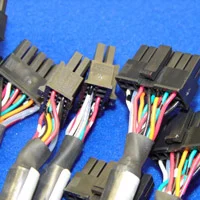A wire harness assembly groups wires, cables, connectors, and other components into an organized electronic or electrical wiring system designed to convey information, transmit sensor signals and/or electrical power. From laptops to automobiles, such assemblies connect electrical components and electronic devices that supply power and send signals for any given system to operate. Thus, the wire harness assembly of any system is necessary to power that system.
Cable Assembly vs Wire Harness
Once assembled, wire harnesses generally consist of multiple branches that run in an equal number of directions with the required terminals at the end of each branch. This is one of the primary differences between a cable assembly and a wire harness assembly. Where cable assemblies are designed to create a path from one point or circuit to another, wire harness assemblies are designed to connect multiple points or circuits with multiple breakouts running in different directions. The wire harness serves multiple functions with multiple terminations for each breakout.
Wire Harness Components
In today’s wiring systems it is not uncommon for wire harness assemblies to be composed of dozens of wires, with hundreds of components and terminations. Each component can affect the performance of a wire harness. Therefore, after the design process has been completed, it’s important to choose the right components for the wire harness to meet its application requirements. Is it for a harsh working environment or a clean interior office space? Will it be exposed to the elements? Or to chemicals, fumes, or temperature extremes? Will there be flexing, or will it remain static?
The answer to these questions will drive the selection process for the right components. Choosing the right wire, i.e., the number and type of conductors, the type of conductive material, the plating applied to the materials, and the stranding of the conductors – is determined by the application. For example, copper is the most versatile conductor material used. Though copper cannot be used alone due to its low resistance to corrosion, it is compatible with other coatings that increase its corrosion resistance. If more strength is needed, then copper-clad steel or alloying copper with cadmium, chromium, and zirconium will increase both flex life and breaking strength.
Corrosion and Moisture
If corrosion is a challenge for the application, then plating will help to improve its conductivity. Plating can provide the necessary corrosion resistance for conductors to function in the most challenging environments. Where moisture is a prime concern, tin is favored for its resistance to corrosion, low cost, and aids in the termination process. For high temperature wire harness applications, coatings such as silver or nickel can enable conductors to work reliably up to 200°C and 260°C respectively.
Conductive Material
Choosing the right conductive material is also important. Selecting a single solid strand of material or many thin strands of material will be determined by the conductive requirements of the application. Where flexibility is needed, use a higher number of thinner strands. If the conductor is to provide power, the size of the conductor will be determined by the amount of current it will carry. Where a signal must be transmitted, then the length and speed will determine the conductor material.
Insulation and Sheathing
The right material for insulation and sheathing the wire harness assembly will also be determined by the application requirements. Material can consist of either thermoset or thermoplastic compositions, which can be designed to meet a wide range of environmental conditions or varying colors for identification purposes. Operating temperature, harshness of that environment, exposure to chemicals & fluids, and the current or voltage requirements the assembly will carry are all factors that must be considered in choosing the right material for insulating the wire harness assembly. For example, extreme temperature applications in a dynamic state of constant movement would require a heavy, rugged sheath to function as designed.
EMI Shielding
Insulation can also serve to counter external electromagnetic interference (EMI). For assemblies of data transmission and communication, twisting pairs of cable or wires will counter EMI, too. Cabling can be used to wrap conductors or twisted pairs of cable together to provide flexibility and a more aesthetically pleasing harness. Proper shielding will further control EMI and any radio frequency interference (RFI) if present. Foil shields, braided shields, and spiral shields are several options available. Selecting the shielding will be determined by the frequency requirements—high or low—and the flex life. A combination of foil and braided shielding offer the best protection from interference at all frequencies, flexibility, but is also a more expensive option. As for the outer sheath, the harness’s protective jacket, the material should meet the physical challenges of that harness’s environment, retain its flexibility and be flame retardant. PVC, a polymeric compound, is the more common and effective jacket for harnesses.
Connectors
 The choice for connectors for a wire harness assembly will relate to the type and speed of the signal being transmitted. The primary options are either a crimp-type connector, or a soldered or welded connection. The type of connector will determine the terminal choices.
The choice for connectors for a wire harness assembly will relate to the type and speed of the signal being transmitted. The primary options are either a crimp-type connector, or a soldered or welded connection. The type of connector will determine the terminal choices.
Lastly, before installing be sure that the wire harness assembly is dressed appropriately. Wires entering and exiting the bundle should be neat and presentable, with strain relief at terminals. When breaking out wires in the assembly, be sure to handle with care and never over bend. To prevent or mitigate strain, which can occur during break outs, mounting or when wires contract and expand during temperature fluctuations, and to accommodate such flexibility, add a maintenance loop before the termination point.
The right wire harness assemblies for today’s wiring systems can be challenging. Once design requirements have been approved for an application, selecting the right components is necessary for a wire harness to ensure its integrity, functionality, and lifespan with only routine maintenance required.


